In the wake of the UK’s departure from the European Union, the government’s Global Britain foreign policy strategy is beginning to take effect.
This article is the opinion of the author and not necessarily that of the UK Defence Journal. If you would like to submit your own article on this topic or any other, please see our submission guidelines.
In a paper released today by the Henry Jackson Society, the author Robert Clark demonstrates how this is the case with the Royal Navy’s upcoming Carrier Strike Group deployment, and, crucially, the intrinsic role that the UK Armed Forces will have in shaping the Global Britain strategy going forwards.

The Royal Navy’s upcoming Carrier Strike Group deployment should rightly be heralded as the first tangible demonstration of what a truly Global Britain will look like on the world stage. Significantly, however, whilst the deployment does represent a tilt to Indo-Pacific region, it crucially also represents Britain’s foremost national interest; maintaining a secure Europe.
This article was submitted to the UK Defence Journal by Robert Clark, a Defence Fellow at the Henry Jackson Society. Robert can be found on Twitter at @RobertClark87.
There are three central tenants to the Global Britain strategy: ensuring a secure and prosperous European continent; the UK as a force for good on the global stage; and championing free and open trade. This naval deployment manages to assist all three strategic interests.
The need to maintain a secure and prosperous Europe underpins the entire Global Britain strategy. A secure continent, particularly lacking one single hegemonic power, ensures a stability in which Britain has historically thrived, enabling it to develop further interests pasts the continental space. The Carrier Strike Group deployment goes some way to achieving this end. Most immediately whilst sailing through the Mediterranean, the group will take part in maritime exercises with NATO partners across southern and eastern Europe.
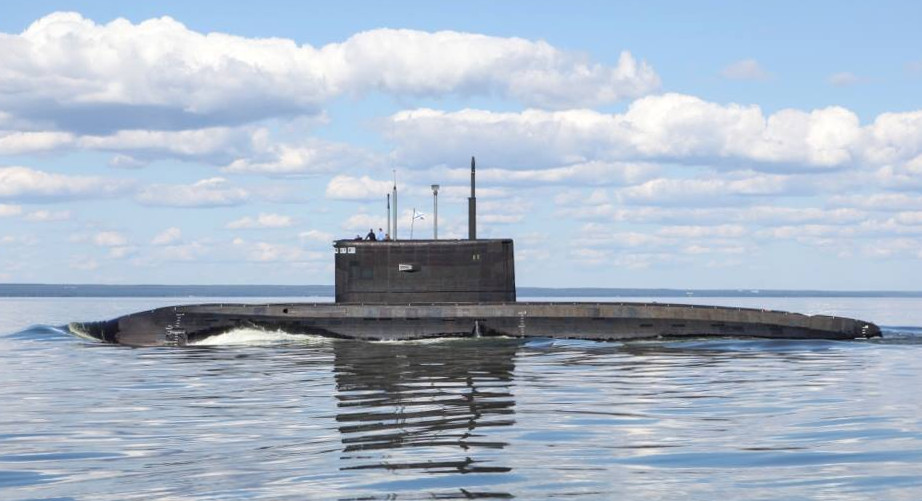
In recent years, the Russian Navy 5th Operational Squadron has launched the Kilo class stealth submarines from their bases inside the Black Sea, as they often pass undetected through the Bosporus and into the Mediterranean on the way to Syria, Libya, and the Atlantic. The act of crossing the Bosporus is in direct breach of the Montreux Convention without prior agreement from Turkey – which Russia often does not seek.
Given the nature of this illegal Russian submarine behaviour in the eastern Mediterranean, a special emphasis should be placed on the NATO exercises this summer to include anti-submarine warfare drills. Furthermore, this is something which the Carrier Strike Group is especially adapted to provide, in the form of the Royal Navy’s advanced Type 23 frigates which provide excellent anti-submarine capability. This should be practiced with our NATO allies operating across the Mediterranean to counter the Russian submarine threat.
Whilst reinforcing European security along its first leg, the group will also provide a significant capability ensuring the safe and uninterrupted passage of European trade, through the Indian Ocean and the South China Sea. Whilst other nations contribute to counter-piracy maritime operations, including off the Horn of Africa and across the Arabian Peninsula, the UK remains the only European power which actively enforces the laws of the sea across the heavily militarised South China Sea.

The Chinese PLA Navy, by some estimates the world’s largest (by tonnage, a crude but still important metric), seeks to increasingly subjugate its neighbours for territorial control over the region’s strategic islands and waterways. This affords a distinct capability for anti-access and area denial to the South China Sea’s crucial shipping lanes, in which approximately 40% of European imports pass through each year.
The Carrier Strike Group is almost certain to conduct freedom of manoeuvre exercises in these waters – likely with regional partners including Australia. The Royal Navy have conducted five Freedom of Navigation manoeuvres through the South China Sea since 2018, second only to the US Navy. These manoeuvres are crucial in upholding the Chinese-contested UN Convention of the Law of the Sea (UNCLOS), and further enable European security and prosperity through ensuring free and safe passage of vessels transiting through.
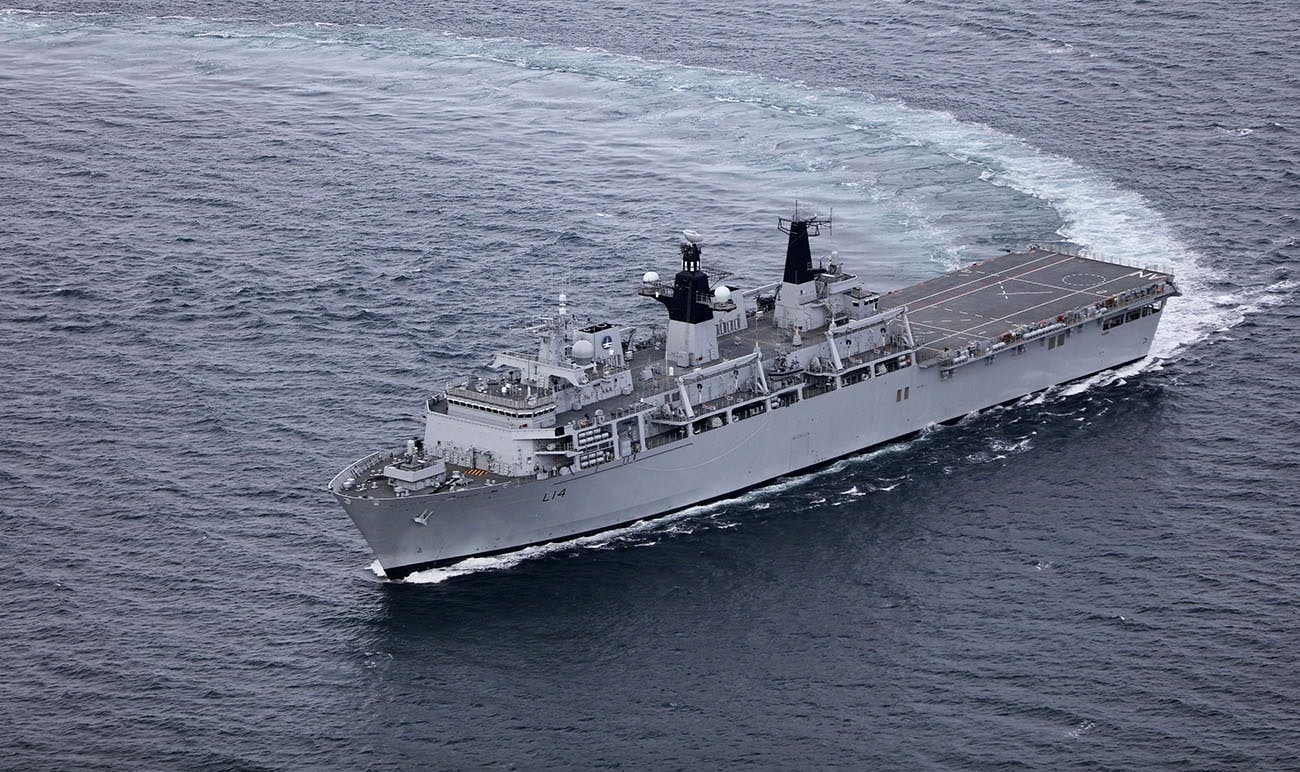
The British political and military will to enforce the UNCLOS – unique amongst European powers – not only directly benefits European prosperity (and thus, security), but also readily reinforces the two further tenants of the government’s Global Britain strategy; acting as a force for good on the world stage, and a champion of free and open trade.
As the UK government is about to release the long-awaited integrated review, already distinct and meaningful elements of its foreign policy agenda for a post-Brexit age can be deduced from the Carrier Strike Group deployment.
At one end of the government’s Global Britain strategy, the Indo-Pacific tilt involves a more forward deployed British military presence, demonstrated by the desired persistent presence in the region. Operating alongside key regional allies including the US, Japan and Australia, Global Britain will continue upholding the international rules-based order, acting as a force for good on the world stage.

At the other end of the strategy, the Carrier Strike Group’s deployment is a meaningful demonstration of Global Britain’s commitment to continually underpinning a secure and prosperous Europe, whilst simultaneously supporting allies and partners upholding the rules-based order further afield.
This is a unique capability amongst European powers – and this is what will define Global Britain.



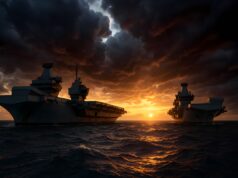
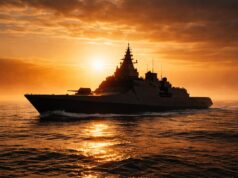



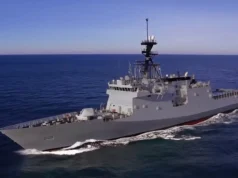
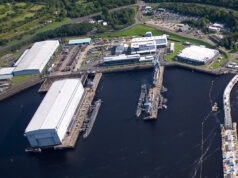


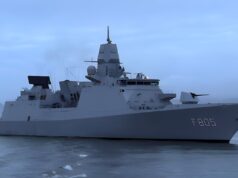

So anybody else think this is just a sales drive in which to flog off one of the carriers?
No.
ermmm…. Nope.
There’s an alternative line of thought. T32 will being the escort numbers up to 24. The MOD is asking for info on UCAV capable catapults. Even supposing F-35B numbers are capped at 48, if we order the FSS ships you might in fact be able to deploy 2 credible carrier task groups at the same time. As the polar ice cap melts there’s an awful lot more sea to control.
I believe that 4 Type 23’s are to be withdrawn before we get any type 26’s, 31’s or 32’s.
It will be irresponsible to withdraw 4 T23 from service at this time! one might be ok.
I didn’t say now but that’s the plan, or so I read.
It seems those 4 ships are laid up at the moment, according this article on Navy Lookout:
https://www.navylookout.com/the-integrated-review-painful-choices-for-the-royal-navy/
The article also suggests that the GP T23’s are in a poor state of repair and may not get their full upgrade. Worth a read.
Cheers CR
I think what will probably happen is just that they will abandon those scheduled for lifex or refit periods between now and when the new frigates are completed. These would not be operationally missed. If we sell them to Brazil say then the new owner can pay for the lifex.
Yes, HMS Monmouth was due for LIFEX soon. Instead, M will be eventually replaced by a T31.
Paul a lot of discussion are happening in Brazil now. The problem is that the Brazilian Navy does not operate Harpoon. We use the Exocet instead. Does not make sense put good money converting old vessels. Especially now, when a new 3500t design already was selected.
I haven’t been following the thinking in Brazil so I will defer to your local knowledge. Out of curiosity what is the 3500 ton design.
Tamandaré Class, by Thyssenkrupp. It is a larger version of the MEKO 100 project. Still, smaller than the MEKO 200. A “MEKO 150” you could say. 4 ships with possibility of two more. Built locally, in Santa Catarina state. Fun fact: Brazil will finally operate the 76/62mm cannon, after 30 years of sales attempt by the italians. The Navy always used british cannons, like 4.5 inch and others. It is bad news that the UK will lose a client on this area.
But don’t be sad. The Tamandaré class will use the new CAMM missile. And the Navy is really enjoing the Artisan 3D radar from the Atlântico, ex-HMS Ocean. This radar have great chance of being ordered for future vessels.
Sounds like a good plan for Brazil. New vessels, local industry skills and jobs, smaller displacement is likely better suited to Brazilian navy needs. The OTO 76mm seems a good gun, widely used. Artisan and Camm is a good combination. I wish you well.
And subs are mentioned, of all things, apparently on ‘safety concerns’. a) not something that would have crept up on the Gov all of a sudden, ergo b) why the years of prevarication before re-commencing a known drumbeat requirement during increasing tensions, c) why then the excessive and continuing unhurried rate of replacement. Of course we would not have run them to being effectively ‘within an inch’ of being unsafe, as any such sudden decision would imply. IF true (we see soon) it’s just an obfuscation over money again.
Regards
If your interested Paul read East o Suez in the analysis section. If we have the will to do it there is no reason why we can’t keep both carriers involved, albeit not at exactly the same times.
Hi Geoffrey. Just read it. Kudos, It’s good work. I will read the comments and say something if I feel I can add anything constructive.
Thanks…appreciate your comments..
No
not “just” since the deployment has been planned a few years. however, it could be a convenient shop window. A little contradictory though since the message will be “hello we’re here, now you see us, now you don’t”
Yes. My bet is Korea.
Aaaargh!
Why arrgh Geoff?
The Turks are on record of asking to purchase one, India is looking at buying one ,the Koreans are building a Carrier based on the British design and I’m pretty sure the Australians wouldn’t say no to a bargain
https://g7a6v6x7.rocketcdn.me/wp-content/uploads/2021/01/ROK-Navy-LPX-II-light-aircraft-carrier.jpg
The latest defense review is just around the corner, we all know that cuts are going to be made and this government has a very good record of selling military equipment off on the cheap.
What has this government sold off cheap?
What would the Turkish embark on one ?
Hi Farouk,
I’m pretty sure I read somewhere that part off the first deployment will be to use the carrier as a forum to promote global Britain, including marketing of the type 31e frigate (amongst other topics I’m sure!). Don’t quote me but I seem to remember reading that fairly recently.
M@
I read that also, but I’m somewhat concerned about the upcoming defence cuts, I suppose its wait and see
I posted this in another thread today.
Hopefully, now we can see the urgency in acquiring some ASM’s.
Saab is a useful partner, not least because they are involved in Tempest but also, they have designed Sea Gripen a 4.5 gen fighter which fits nicely into the weight category specified for cats and traps for the QE class.
They also manufacture a very useful ASM themselves which is in the process of being upgraded.
RBS15 Gungnir, a next-generation anti-ship missile system.
“The surface launch version of RBS15 Gungnir uses the all-new RBS15 Mk4 Surface missile. This provides greater range, enhanced defence penetration and electronic protection as well as a more advanced target seeker, allowing it to engage any target, in all conditions.
The RBS15 Mk4 Surface missile is used in both the sea system and the land system of RBS15 Gungnir. It is designed to provide commonality through easy integration on both land and sea-based platforms of almost any size. The system is fully backwards compatible, so an investment in Mk3 today opens a smooth path to transition into Gungnir tomorrow.”
“I see them developing systems, capabilities, and a posture that would indicate that they are interested in aggression … I cannot for the life of me understand some of the capabilities that they’re putting in the field unless it is an aggressive posture,” he said, adding that he fears Beijing might attempt to seize control of Taiwan before the end of this decade”
https://www.janes.com/defence-news/news-detail/military-balance-in-indo-pacific-region-becoming-more-unfavourable-to-us-says-adm-davidson
Hello Nigel… can you tell us more about the ” Cat’s and traps for the QE class” please, Is this something we have all missed or ref to the recent article much debated on here ?
Much debated by all on here or, the ones that may have missed it?
You stated that it was for the QE class…. I’ve not read that anywhere. Just interested to see a link.
UKDJ didn’t state the enquiry from the MOD was for the QE class but the 3-5 year time frame had started a debate in the comments section as to which vessel they would be fitted to and some made the logical leap that it would be the carriers.
https://ukdefencejournal.org.uk/mod-looking-at-cats-and-traps-to-launch-aircraft-at-sea/
Logical in the fact that they would be fitted to Carriers but we all know the history and political fall out. Also the cost’s at the time were huge.
To back Nigel up. The supposition is based on the specifications of the MoD’s RFI, i.e. too small for manned aircraft but rather large for small UAVs, plus it would be wasted on any other ship. As the cats and traps give the carrier significantly more options. There is also the case announced by the RAF and BAe, who stated that the Tempest program will be fully integrated with carrier strike. Does this mean a marinized version of Tempest, probably not! However, Tempest is a system of systems program, which also incorporates UAVs in the form of LANCA, the loyal wingman program. Then the MoD and RAF have also stated that LANCA/loyal wingman will be fully integrated with the F35B.
The logical leap (I know this is the MoD we are talking about!) is that an EMALS launcher will be fitted to the carriers, probably just the one to begin with, in the port waist side or adjacent to the ramp along with a arrestor wire recovery system. Will they include an angled deck, possibly purely for safety reasons. With the aim of launching UAVs to support the F35s. This could just be for the LANCA loyal wingman type UAV. However, the requested specifications are a perfect match for Boeing’s MQ-25 Stingray UAV, which is going to be used for air to air refuelling along with a bit of ISTAR. Fingers crossed that someone in the MoD has looked at this program and stuck it on a “we need some these list”!
More than likely it appears.
“The systems, known as ‘cats and traps’, would likely be fitted to the UK’s new Queen Elizabeth-class aircraft carriers to increase the combat mass of the UK’s F-35Bs by augmenting them with uncrewed aerial vehicles (UAVs).”
https://www.naval-technology.com/features/uk-carrier-cats-and-traps/
Boeing are currently carrying out F18 Super Hornet ski-jump launch trials with trap recovery. If Boeing think it possible on a legacy platform, to not seriously investigate the potential as part of the more advanced, IT Tempest would beggar belief!
The Global effort will increase year on year, until some international agreements can be achieved that takes some of the steam out of the thrust for oceanic supremacy.
I believe many Western counties will increase defence spending on the expansion of surface fleets. As I’ve suggested before, I think the main thrust of MOD expenditure is heading towards the Admiralty.
I wonder when we’ll see a PLAN carrier sail up the English channel ?
What would it’s point be? We are not attempting to occupy any sea that is otherwise legally regarded as international waters.
So why would it waste time transiting through the channel? But if it wants to, let it?
Same as ours ?
Oddly I don’t think you actually need cars’n’traps to do an assisted takeoff.
The power consumption approximations I did on the other thread gave me an idea and I’m pretty sure the physics works.
You don’t need to carve up the deck or anything.
But I’m musing on it before I realise that I dropped a zero in public.
Sometime soon.
Not sure if you or others read my post on here last year on this subject or not?
The melting Arctic ice cap is opening up a new passage into the Atlantic for the expanding Chinese Navy in a potential new challenge to the UK and the west, the chief of the Royal Navy has warned.
Russia is also likely to assert itself even more in that part of the Atlantic, a strategic area for Europe and the US, said Tony Radakin, the First Sea Lord.
https://www.independent.co.uk/news/world/china-military-arctic-ice-caps-melt-uk-navy-russia-tony-radakin-b889695.html
Yes mate, I remember reading that. I can see a Tit for Tat transit getting nearer.
Agreed!
Brilliant! Use global warming as a reason to keep taxpayers money flowing into defence. The ice only freezes near the surface so transit by nuclear subs has been possible for decades.
This isn’t blue sky thinking, it’s just silly scaremongering.
I’m not so sure to be quite honest Peter S after reading this.
https://www.nationalgeographic.com/environment/article/new-cold-war-brews-as-arctic-ice-melts
Interesting article but the conclusion about the impossibility of large scale military operations seems right.
Russia is the big player and has the ships to risk the ice dangers. But China? It’s further away from the north pole than Mexico is. The only access to them would be the Bering Strait, easily controlled and defended from Alaska.
And all this only if global warming forecasts are correct.
There are more likely things to worry about.
China now the largest navy, by one measure at least, in terms of manned platforms i.e. including patrol boats, through corvettes, frigates, destroyers, amphibious and on to carriers, plus SSN & SSK. Furthermore, I’m pretty sure they can be depended upon to augment, not significantly replace, these traditional platforms with USV/UUV during the foreseeable term.
Also read up on “China’s Maritime Militia”
I think Borris should drop the phrase global Britain if these massive cuts come true token forces spread thin around the world is not a improvement, and yes I admit I’m doomsayer and I am happy(relieved) to be proved wrong.
What massive cuts? He has only recently announced that defence expenditure will increase by £16 million plus. There is certainly going be a restructuring which is long overdue and then a steady growth in areas that we consider to be most important.
Steady growth? If your key equipment costs keep outstripping general inflation, even the expected 0.5% annual increase above inflation means you cannot afford as much. The NAO report on the 10 year equipment makes this clear. The extra£16 m over the next 4 years is in part to fund new space and cyber with the rest to meet the large forecast shortfall in the early part of the 10 year plan, ( big expenditure on F35, Ajax,Boxer).That’s what underlies the rumours/leaks of major cuts.
It seems clear there will be a major commitment to Tempest which will have to be funded from reductions somewhere else.
And additional funds would be needed to buy more than 48 F35.
It really is that bad.
£16b.
Then I ask you GR what use is only 68.000 men in a conflict ?, as people commented before me , there is balance in numbers and quality in a equipment, the balance in numbers in terms of cuts is criminal , read my other comments , afghan campaign over 100,000 army force and struggled to continue the campaign with 10.000 ,that should of been a wake up call back then, but no more cuts in mass.
I presume your talking about bringing back conscription then Dave because how else are we going to recruit the mass your talking about when at the moment we can’t even keep up an army of 82000, persistently five to ten per cent undermanned.
I don’t like these figures any more than you do but we have to deal with facts. To be blunt the army is a shambles beset with problems that will take ten years to sort out so we have to start with the best we have and build from there.
Its no excuse GR ,since when have we had to bring back conscription , the cuts of the UK army have been down to government for the last 30 years and while we as a nation have always managed to afford it. As i keep mentioning before, we had an army of over 100,000 but could only field 10,000 troops in Helmand. Of all you can say, 68,000 troops is not very well good enough in any modern army ,let alone a false promise of global GB. Put your money where your mouth is, or we will lose armed forces personnel like we did in the pre Falkland war cut backs.
Dave…did you actually read what I said. I’m not making excuses for any body. I’m stating a fact. We cannot recruit to 82000 so how do we get to 100,000 and if by some miracle we did reach that number what would we do with them?
I agree Geoffrey, a whole scale reorganisation of the Army in particular is needed. I’m uncomfortable about loosing any more personnel from the ranks, but we do have to seriously ask what we need our Armed forces to do.
Personally, I think it it should be shaped as an out of area rapid reaction force.
Be able to rapidly transport and support 6,000 troops anywhere in the world. A heavily armed and very well equipped, scalable force structure.
After giving it a great deal of thought, I think we should get rid of heavy armour and ensure the bulk of equipment is air transportable by the C17/A400 fleet, this transport fleet should also be expanded.
I would also increase the AH64E fleet and ensure the CH47 fleet is deployable, kept up-to-date, with high availability.
Let Germany and Poland concentrate on Armoured warfare.
I’m not sure using the Afghanistan operations is a great example, maintaining 10,000 troops in country accomplished very little in reality….
We need to avoid open ended deployments with specific ( and achievable) mission goals, otherwise, it leads to mission creep and invariably into an insurgency situation you simply cannot win. That’s a painful lesson I hope to Christ we have learned!
Numbers aren’t everything, when the Army was 150,000 back in the eighties, the bulk of the combat force was concentrated in BOAR (50,000 troops from memory), 900 odd tanks on the books and configured into Armoured divisions.
Sounds good on paper, the reality, is the force was dreadfully underfunded and always short of supplies, only a relatively small number of these tanks were ready to deploy at short notice…..
It would have been a bloody shambles had the balloon gone up with little warning….
I would rather have a smaller, lean and mean, deployable highly mobile force, well equipped and supported and trained to the highest levels.
Bang on John. I couldn’t agree with you more.. my own thoughts are in the Analysis section..The British Army..towards 2030 Saves repeating myself!
I make a concession to armour in that I’ve allowed for two small A.I. brigades properly equipped to backed by serious FIRES to support the northern flank. In part this also to do with our leadership of the J.E.F.
I would avoid the likes of Afghanistan and the second Iraq war like the plague. To this day, apart from political desire, I don’t understand how we got sucked in to two wars that we were hard put to contribute properly.
This might interest you.
Moving forward I see the army in the same way you do. I’ve based my ideas on an enhanced 16th A.A.B. able to go anywhere fast and a properly organised Strike Brigade, at least part of which should be forward deployed to where it might do the most good.
Transport does need expanding. If there are plans to scrap the Herky Birds that is a mistake
I should also bring in the Royal Marines of course.
Enjoyed the read…stay safe.
And Women……
lol.
Well said that man,can’t be a Global Britain if he thinks it’s time to cut .Like I’ve said before he needs to smell the coffee.
“…Kilo class stealth submarines from their bases inside the Black Sea, as they often pass undetected through the Bosporus and into the Mediterranean…”
So Turkey should take action then, by deploying anti-submarine nets, underneath across the Bosporus, especially if the Russians are in breach of the Montreux Convention.
Great Idea !
Yes, made me think it’s somewhat alarming that they can get through one of the narrowest choke points on earth, 100mtrs greatest depth, passed a NATO ally that spans both sides of the waterway!
Ive just been Watching some Videos of Warships Transiting the Bosporous,i think that Claim is BS if im Honest.
You’d like to think so. The inference is OSINT: sub was in X, now in Y, how come Turkey not advised? and that NATO happy with the assumption since they’re quietly monitoring by hydrophone, etc. Of course, Istanbul on both sides of Bosphorus makes transit across one of noisiest anywhere, which would not help. Still, one would further assume that entrance to the Bosphorus & exit from Dardanelles likely to be covered. Eitherway, issue should be resolvable.
Indeed – heres one they did notice -: https://www.youtube.com/watch?v=4Aaxe1gOetw
I might be a voice in the wilderness but when I hear about cuts and a general focus by contributors to this site on the impact that will have on carriers and Army numbers etc. it makes me wonder if someone up there knows that it is possible to create a lot of damage with inexpensive weapons and possibly (just possibly) in the future we won’t just be counting hulls and people we might just be looking at the damage the kit and/or people can do. On the other hand I am more than aware that sometimes generals and politicians are bumbling fools fighting the last war. Perhaps I am living in hope.
Wasn’t that Dom. Cummings view? I mean on low tech weapons making large high tech platforms ineffective.
DC for all his faults could smell BS a mile away. He knew that the big defence contractors need to sell big expense stuff and he knew the MOD procurement people were geared to buying big expensive stuff. I don’t think the expensive high tech platforms would be ineffective just we can’t afford them in sufficient quantities. Could low tech inexpensive stuff have a role – maybe?
Exactly Mark. i had the same view on DC.A balance between quality and quantity, my using stuff not quite as gold plated as the rest. That, at least, has always been my hope.
I see no other realistic way to increase numbers in areas that matter.
I totally agree. It also opens the market to smaller defence contractors who might be able to produce in production line numbers simple effective quality products.This could well make defence affordable – we will see. I wonder if the DR will still have the tell-tale fingerprints of DC on it?
Exactly what the US appears to be considering for their airforce and has been for a while to combat the ever-increasing military might of China, within the next ten years it seems?
https://www.forbes.com/sites/davidaxe/2021/02/23/the-us-air-force-just-admitted-the-f-35-stealth-fighter-has-failed/
I can certainly see the issue from the US perspective. If anything the planes should have been shedding kit rather than building in more. Keep it simple. Most of the time you are trying to move (& control/use) weapons and sensors to the battle area and bring them back if unused. It’s not hard but we perhaps all have preconceived ideas of what’s needed. Perhaps some of it isn’t?
Viz-a-viz my above conjecture over the IR and subs, what’s the problem with a few SSK for fulfilling many tasks. We’re espousing that rationale over surface units, and the submarine threat is both massive and another forte of ours. All well and good just SSN if we can keep up production – otherwise?
I agree and wonder what became of the hi lo force mix concept in vogue some years ago. It’s especially needed in air platforms where 5 th generation planes are blowing the budget. Type31 is I suppose an example but it is still an order of magnitude dearer than the type 23. France is ordering Griffon ifv to do much the same job as Boxer but at 20% of the cost.
A lot of hope is being pinned on unmanned systems but they aren’t cheap either.
“Type31 is I suppose an example but it is
still an order of magnitude dearer than the type 23.”
The first in the class T23 HMS Norfolk, cost £266M in 2007 prices. Real price was £130M in late 80’s.
The last T23 cost £199M in 2007 prices.
Those prices would Not have included GFE like the TAS(towed sonar), Sea Wolf/Sea Ceptor.
It’s hard to pin down exact prices. Type 23 build costs did fall over what was a long programme. The last couple are thought to have cost @ £80/90m in 2000 which would give say £150 m today. Even when a cut price new ship like Type31 is ordered, the cost is now pushing £400m ( per NAO).
I couldn’t think of another example where we had deliberately chosen a lower spec piece of kit to try to stretch the overall budget. It just shows how difficult it is.
The 23 looks to have been a bargain.
As they say Daniele, quantity has a quality all of it’s own. Mark’s comment is very valid. From the Antipodes to all of you in the UK – best of luck for the outcome on Tuesday the 16th.
I’m optimistic some good will come from this, after all a $24 bill increase is a chunk of change. Keep the faith all!
I think most of us guys my be in some sort of bunker on 16th but will try and keep faith but it’s been hard to do so over the years ,Especially in the world of today.Looks like most of our PMs,and MPs are stuck in the 90s.
I agree it seems simple logic that your major assets are going to be slaughtered in a ‘modern’ conflict. But I remind myself that the issue was not unknown. During WWII the UK committed what assets it could spare from the Altlantic and other arenas to challenge the Italians in ‘Mare Nostrum’.
On the face of it many contemporaries must have thought the RN on a hiding to nothing. We had two bases at opposite ends of the Med, Gib & Alex, with the powerful, modern-unit Regia Marina, backed up by the Aeronautica (the latter supplemented by the Nazi Luftwaffe later on with, yes, a few missiles at the end!), slap bang across the middle. We ‘contested’ that centre territory with tiny Malta. For much of the time we had ”laughable’ aircraft on one carrier, never more than two for a short stretch.
How could that possibly have come off? Well, independent-minded Command, good training & tactics, critical shipborne technology and intelligence/misinformation went a long way. Probably the most celebrated single exploit was the attack on Taranto utilising the laughable aircraft, something that memorably impressed the Japanese, though Matapan and other instances were rife.
As a tragic counterpoint, Force Z (in the SCS, ironically) was lost to an extent by the failure of the RAF to come good on an undertaking to cover for the lack of a carrier.
For consideration,
G
Good narrative G $& testament to the fighting spirit of the RN; I would add though the RN were aided by the unwillingness/inability of the Italian Navy to take a more aggressive stance , and their ineffectiveness to fight the RN.
Different kettle of fish re the Luftwaffe sinking RN vessels in numbers. Not to mention the returns posted by six or so u boats in the Med- 2 carriers,1 battleship an several cruisers sunk by them.
Good day, K. Cheers. Yes, losses are unavoidable with Crete the worst case scenario. I’d debate that the losses there were magnified by the evacuating vessels being constrained in their inability to dictate a fleet strategy, their likely positions being predictable and thus negating maritime manoeuvre.
Regarding Italy, remote HQ dictates were one significant factor compared to the independence allotted and assumed by Cunningham – and something that today I feel would be a hindrance if our commanders feel too hidebound by rules of engagement during unexpected confrontation; we’ll see. But in the end the RN won – to the extent that you can in war – the Med, to my mind amazingly.
Of course I, and others, would have taken one look at the likely outcome there and demurred; if we didn’t, we’d have lost regardless! I suspect that even the mighty Dom may have faltered, lacking the requisite maritime strategic and tactical familiarity.
Hopefully, we still have commanders like Leach & Woodward (the latter a near neighbour in his time) somewhere in the mix, rather than officers who look all too often to pass an command exam after a relatively short sea spell, say. The above two faced a less serious, but not totally dissimilar, dilemma during the Falklands campaign, compounded by a lack of escort vessel armament. Many doomsayers not comprehending their confidence and tactical nonce.
Regards.
An excellent read, Robert, thank you. Some very valid point.
Just a thought from an old pedant – I think you mean ‘tenets’ rather than ‘tenants’…?
Good read Robert.. We obviously have very similar views, at least on East of Suez.
I’m really annoyed by this constant sucking up to the EU that frankly does not care about British lives let alone security. From what I see the EU wants an EU Army and wants integrate Britain into its defence architecture. The Idea of an independent Britain partner equal with Europe is unacceptable in Brussels. Tempest alone and Galileo satalite says a lot about European plans . Britain must go it’s owns ways and some day Europe will turn to Britain
All is not well in Europe…..
I agree James just the other week there were arguing over covid vaccines .We Brits most keep well away from an EU Army .
Couple of points. The EU does not equal Europe, the latter being a geographic area which includes the UK.
Secondly, the UK still wants to trade with other European countries, whether those countries are within the EU, or in some other relationship with the EU, such as Norway and Switzerland. We care about the economic health of European countries, regardless of whether a country is within the EU or not, because that is likely to directly impact our level of trade with them and by implication our own economic well being. Hence one of the key tenets of “ensuring a secure and prosperous European continent”.
In defence terms we also care about the economic health of European countries, because lack of it impacts political stability and tends to drive extremist political views, that give rise to increased security concerns.
It does look impressive but then again it should as it has cost us a quarter of our army.
Blimey, On that basis POW has cost another quarter then !